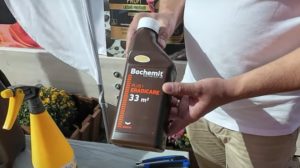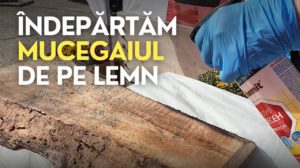Natural patterns and certain treatments such as structuring or artificial ageing are more visible when the wood is stained. The effect is accentuated when patinas appear, especially if the wood has large pores that form a specific natural pattern (oak, ash, mahogany, elm). There are also wood stains that act as a combination of stain and patina, better highlighting the pores and structure of the wood. We have detailed the application of this type of bath. You have the link to the video at the end of the article. The boy was made available to us by Lomilux, partner of the Wood Magazine project Finishing Guru.
A larger-bodied, viscous bath will function as a bath and skid system
Simple bleaches are dyes dissolved in water or thinner. When applied to wood, they color it without adding any special effect. The more viscous bards, also called glazes, have a more elaborate composition, allowing us to achieve different effects. The most common is the pore marking and the pattern obtained by structuring or antiquing wood. The thicker balm will fill pores and new structures, highlighting them.
Wiping off after application helps to amplify the effect, as the bath product is pushed into the pores and into the 3D pattern that emerges after structuring. The surface of the wood will look as if it has been patinated, with the pores very well marked. The patination effect is best seen on frames or profiled or carved objects, with the bath remaining in corners and hard-to-reach areas.
To allow time for wiping, the glaze should not dry quickly. Such products dry in 12 hours or more. The presented bleach has the advantage that it is solvent-based, with a drying time of only 4 hours. The drying time cannot be reduced very much because the stain remains as a patina in the harder to wipe off areas. It takes time for the solvent to get out of the remaining thick layer.
Another advantage is that once the 4 hours drying time has passed and the thinner has evaporated, it can be coated with both solvent-based and water-based primers and varnishes.
With solvent baths, the fiber lifts less and sanding between coats is easier
Being a solvent-based wood stain, it also has the advantage that the wood fiber does not rise very much. Wood is water-loving and when the water gets to the wood in the form of a water-dilutable bath, it absorbs more water and the small fiber ends rise. The primer applied after the bath covers the fibers and after drying they become rough and hard. So that the final surface is not rough, the hard fibers must be sanded away. This is the reason for sanding between coats.
And with solvent-based polishes, the fiber rises, but much less than with water-based. Sanding between coats is easier, and a fine, nicely textured surface is achieved more quickly. Sanding paper is less damaged and lasts longer. Also, the sanding effort is reduced.
Applying a clear coat of primer or varnish over the dry grout will change the appearance slightly
After drying, the wood surface is protected with primer and/or varnish. The appearance changes and becomes brighter. The impression is that the varnish becomes more transparent and the wood is more visible than before priming. The effect is most noticeable on white stain. To reach the desired intensity it is best to test beforehand.
Depending on the primer used, the color may also change slightly. Lacquers and primers give a slight yellow tint to the grouted surface, most noticeable with white grout. The ones that change the appearance the least are solvent-based acrylic varnishes and primers. This is the varnish used in the movie below.
If you have any questions about how to apply it or about the bath bath's features, leave them below in the dedicated space. I will be sure to reply.




































Add comment